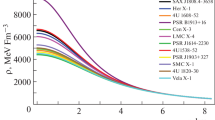Abstract
We study the effects of anisotropic pressure on the properties of spherically symmetric, gravitationally bound objects. We consider the full general-relativistic treatment of this problem and obtain exact solutions for various forms of the equation of state connecting the radial and tangential pressures. It is shown that pressure anisotropy can have significant effects on the structure and properties of stellar objects. In particular, the maximum value of 2M / R can approach unity (2M / R < 8/9 for isotropic objects) and the surface redshift can be arbitrarily large.
Similar content being viewed by others
REFERENCES
Clayton, D. D. (1983). Principles of Stellar Evolution and Nucleosynthesis (The University of Chicago Press, Chicago).
Kippenhahn, R. and Weigert, A. (1991). Stellar Structure and Evolution (Springer-Verlag, Berlin).
Glendenning, N. K. (1997). Compact Stars: Nuclear Physics, Particle Physics and General Relativity (Springer-Verlag, Berlin); Heiselberg, H. and Jensen, M. H. (2000). Phys. Rep. 328, 237.
Ruderman, M. (1972). Ann. Rev. Astron. Astrophys. 10, 427.
Canuto, V. (1974). Annu. Rev. Astron. Astrophys. 12, 167.
For comprehensive reviews see, Liddle A. R. and Marsden, M. S. (1992). Int. J. Mod. Phys. D 1, 101; Jetzer, P. (1992). Phys. Rep. 220, 163; Mielke, E. W. and Schunck, F. E. (1998). In Proceedings of 8th M. Grossmann Meeting, T. Piran (Ed.) (World Scientific, Singapore).
Sawyer, R. and Scalapino, D. (1973). Phys. Rev. D 7, 382.
Bowers, R. L. and Liang, E. P. T. (1974). Astrophys. J. 188, 657.
de Leon, J. P. (1987). J. Math. Phys. 28, 1114.
Gokhroo M. and Mehra, A. (1994). Gen. Relativ. Gravit. 26, 75.
Bondi, H. (1992). Mon. Not. R. Astron. Soc. 259, 365.
Corchero, E. S. (1998). Class. Quantum Grav. 15, 3645.
Herrera, L. (1992). Phys. Lett. A 165, 206.
Herrera, L. and Santos, N. O. (1997). Phys. Rep. 286, 53.
Weinberg, S. (1972). Gravitation and Cosmology (Wiley, New York).
Tolman, R. C. (1930). Phys. Rev. 35, 875.
Hartle, J. B. and Thorne, K. (1968). Astrophys. J. 153, 803.
Misner, C. and Zalopsky, H. (1964). Phys. Rev. Lett. 12, 635.
Gleiser, M. (1988). Phys. Rev. D 38, 2376; Gleiser, M. and Watkins, R. (1989). Nucl. Phys. B vn319, 733.
Dev, K. and Gleiser, M. (in preparation). Anisotropic Stars: Perturbations.
Author information
Authors and Affiliations
Rights and permissions
About this article
Cite this article
Dev, K., Gleiser, M. Anisotropic Stars: Exact Solutions. General Relativity and Gravitation 34, 1793–1818 (2002). https://doi.org/10.1023/A:1020707906543
Issue Date:
DOI: https://doi.org/10.1023/A:1020707906543




